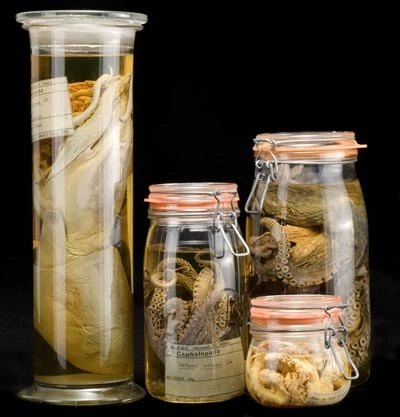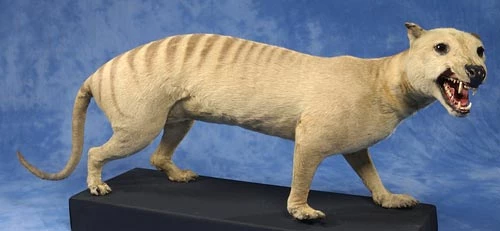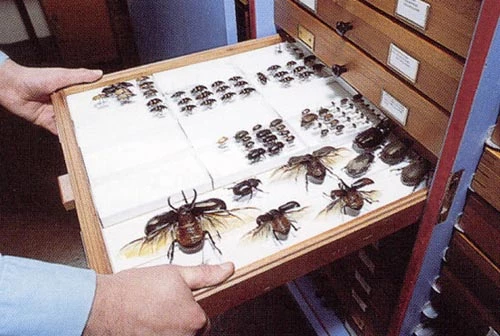Looking after DNA in Natural Science Collections
Fluid preserved specimens over a hundred years old and are a potential source of DNA studies.
The Extinct Tasmanian Wolf.
DNA extracted from the skin of Museum specimens has been used to study the relationship of the Tasmanian Wolf to other marsupial animals.
Historic insect collections are a valuable source of future genetic studies.
The growing crisis in the world's biodiversity has created new demands on the biological collections held in museums. In addition, modern techniques are allowing us to look at our collections in new ways such as analysis of DNA (Deoxyribonucleic acid). It is now possible to extract and read the DNA from museum specimens but this can depend on how they have been stored and preserved.
Irreplaceable collections
Over three million biological specimens are housed at Amgueddfa Cymru. As the pressure on our natural environment increases, these collections are becoming an ever more important resource. Many of the species collected are now either extinct or so highly endangered that further collection is not possible. Many of these specimens are irreplaceable and vital in helping us understand biodiversity and climate change.
Preserving biological material can be very difficult. Biological material, including DNA, decays rapidly. Chemical treatments are aimed at preventing this decay, allowing the long-term preservation of biological specimens.
Early preservation
Preserve museum specimens date back over 300 years. Initially only dry and inert specimens could be preserved. Alcohol was first used in the 17th Century, formaldehyde (formalin) was introduced in the 19th Century. These methods enabled a wide range of specimens to be preserved - but were developed before DNA was known about.
It can be very difficult to obtain DNA from specimens preserved using formalin. Other chemicals, such as ethanol (alcohol), are useful in the preservation of both the specimen and its DNA.
Using DNA from the collections
DNA can be used in many areas of study, such as work on evolution, species identification, and ecology. DNA studies at Amgueddfa Cymru include:
- Researching Hunter snails from East Africa and using DNA to study how they are related to each other.
- Freshwater pearl mussels are highly endangered in Wales. Museum researchers are using DNA to look at the genetics of the remaining populations to help in their conservation.
- Lichens are an important aspect of biodiversity, but difficult to identify. DNA is being used to help identify lichens.
DNA - a fragile resource
Unfortunately DNA can be damaged in many ways. Following the death of an organism, DNA molecules break down very quickly. This means that careful and quick conservation of specimens is needed to ensure the preservation of the DNA as well as the specimen as a whole.
The museum is involved in researching methods of DNA preservation. One method is storage in -80°C freezers or liquid nitrogen. Some museums have already set up frozen-tissue banks, but these methods are expensive.
Ongoing research aims to improve our understanding of the effects of these treatments, helping us keep our specimens DNA intact for the future.


